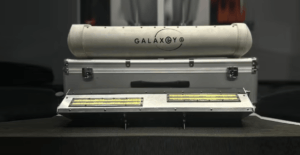GalaxEye Secures $6.5M Funding to Launch Drishti Mission and Advance Satellite Imaging
GalaxEye Space secured $6.5 million in Series A funding to launch its first satellite, Drishti Mission, and enhance its multi-sensor imaging technology. The startup is pioneering the integration of optical MSI and SAR for continuous, all-weather Earth observation. It also plans to develop UAV SAR systems for defense in collaboration with ideaForge.
CONTENT:

GalaxEye Secures $6.5M Funding to Launch Drishti Mission and Advance Satellite Imaging
GalaxEye, a Bengaluru-based SpaceTech startup, has reached a significant milestone with its GLX-SQ payload aboard ISRO’s PSLV Orbital Experimental Module (POEM-4). This mission marks the world’s first successful integration of Synthetic Aperture Radar (SAR) and optical imagery in orbit, setting a new benchmark in space technology.
ISRO’s POEM platform, which transforms the fourth stage of the PSLV rocket into an operational space lab, enables real-time testing of advanced payloads. GalaxEye’s GLX-SQ not only completed its primary mission successfully but also operated in one of the most challenging regions of space—the South Atlantic Anomaly (SAA), often called the “Bermuda Triangle of Space.” This area is characterized by a weakened magnetic field, which exposes satellites to heightened radiation levels, potentially causing electronic disruptions.
Despite extreme conditions—including high radiation exposure and temperatures dropping below -10°C during an eclipse—the GLX-SQ payload functioned flawlessly.
“This achievement surpasses standard payload testing,” stated Suyash Singh, CEO and Co-founder of GalaxEye. “By successfully operating in the SAA during an eclipse, we have demonstrated our technology’s resilience under the harshest space conditions.”
The mission highlights several key advancements:
- Seamless SAR image capture and processing despite radiation challenges.
- Continuous operation through sub-zero temperatures in eclipse conditions.
- Effective performance of thermal insulation systems in extreme environments.
This multi-sensor satellite program aims to enhance applications across defense, agriculture, and disaster management.
GalaxEye’s GLX-SQ Payload Achieves Milestone Aboard ISRO’s POEM-4
Bengaluru-based SpaceTech startup GalaxEye Space has secured $6.5 million in a Series A funding round, co-led by Mela Ventures and Speciale Invest. The round also saw investments from ideaForge, Rainmatter, Navam Capital, Faad Capital, and Anicut Capital. Notably, ideaForge’s ₹8.28 crore investment for a non-controlling stake, reported last month, is part of this funding round.
The newly raised capital will support the launch of GalaxEye’s first satellite, the Drishti Mission, aimed at advancing its multi-sensor payload technology, enhancing laboratory testing infrastructure, and expanding its team, according to Co-founder and CEO Suyash Singh.
GalaxEye is developing indigenous satellites equipped with optical multi-spectral imaging (MSI) and synthetic aperture radar (SAR) technology, enabling continuous, all-weather Earth observation. These capabilities are expected to benefit industries such as defense, agriculture, and mining.
“GalaxEye is pioneering the fusion of MSI and SAR technology, a breakthrough that could transform the way satellite data is captured and utilized, providing real-time insights across multiple sectors,” said Vishesh Rajaram, Managing Partner at Speciale Invest.
Founded in 2021 by a team of engineers from IIT Madras who had previously participated in SpaceX’s Avishkar Hyperloop competition, GalaxEye had earlier raised a pre-seed round from Speciale Invest in June 2021.
The company plans to launch its first satellite in the second quarter of 2025, followed by two more in 2026. Singh highlighted that while GPS underwent a transformative shift in the late 1990s—improving accuracy from 50-80 meters to around 10 meters—the satellite imaging sector has yet to experience a similar breakthrough. GalaxEye aims to change that by ensuring continuous Earth monitoring, regardless of weather or time of day.
“With Drishti, we aim to combine MSI and SAR data, bringing the satellite imaging industry closer to a GPS-like revolution,” Singh added.
Beyond space-based observation, GalaxEye has also developed an unmanned aerial vehicle (UAV) SAR system for defense applications, with plans for commercial deployment in 2025. Through a partnership with ideaForge, the company is designing SAR payloads for drones, which will be capable of penetrating fog and dense foliage—crucial for defense and security operations. Their collaboration includes a UAV featuring Foliage Penetration Radar, developed specifically for Indian security forces.
GalaxEye has also established partnerships across various segments of the satellite industry, including platform systems, satellite assembly, testing, and launch operations. Its advisory board features experts from organizations such as DRDO, Waymo, ISRO, and Swiss Re.
Check out TimesWordle.com for all the latest news
You must be logged in to post a comment.